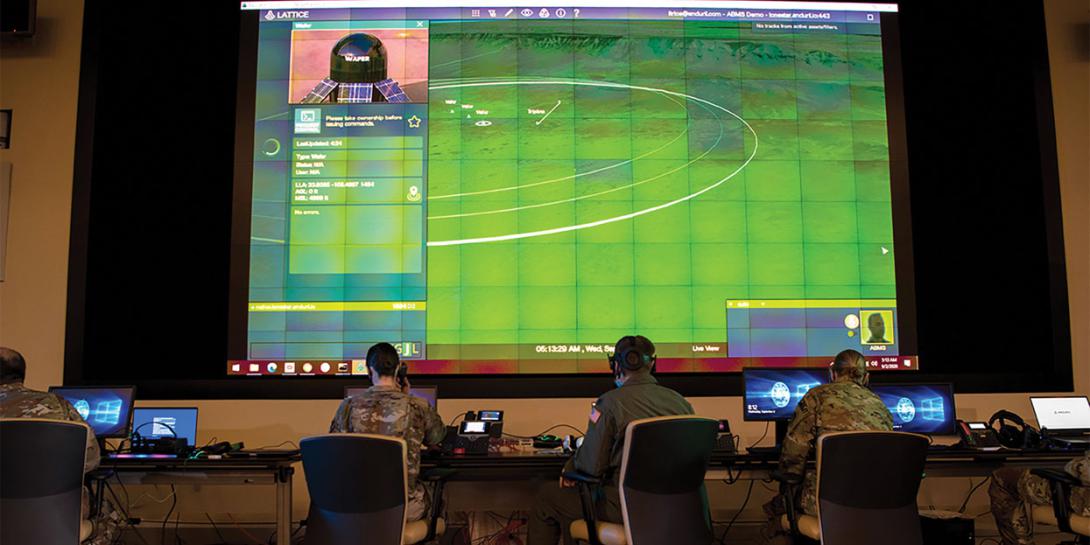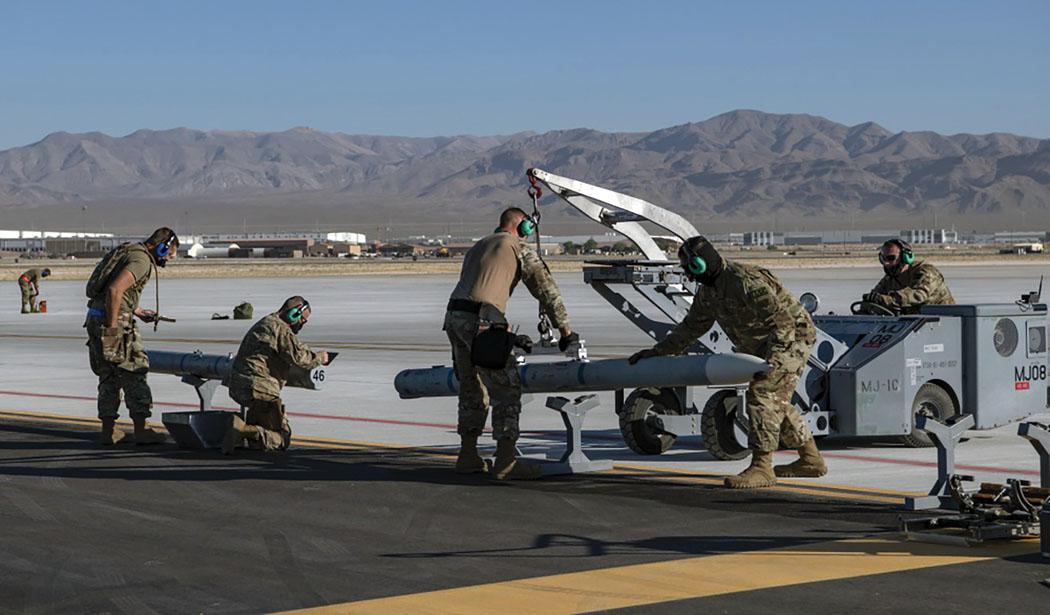Holding the Line for Joint All-Domain Command and Control
The U.S. military is rapidly pursuing Joint All-Domain Command and Control, known as JADC2, as a way to confront near-peer adversaries China, Russia and other nations. The effort requires innovative computing, software and advanced data processing; emerging technologies such as artificial intelligence, cloud and 5G communications; along with integration of the military’s existing legacy systems. Leaders have learned that to fully implement JADC2, they have to shed some of the military’s old practices.
They are lessening the propensity to accept proprietary solutions from industry and are holding the line on any requested interoperability or cyber extensions for legacy systems, says Lt. Gen. Bradford Shwedo, USAF, former director, Command, Control, Communications and Computers (C4)/Cyber; chief information officer, Joint Staff, J-6. Gen. Shwedo will retire from the military on December 1. Lt. Gen. Dennis Crall, USMC, took over the J-6 role on October 5.
Over the last year—minus delays because of the pandemic—the military has actively pursued and tested the concept of being able to connect every sensor and data feed to a tactical network. This would enable any warfighting option, kinetic or nonkinetic, across the sea, air, land, space and cyber, by any service, whether it be Army, Navy, Air Force, Marine Corps or the Space Force.
As part of the goal for joint all-domain operations, or JADO, by 2023, the military is expanding the participation of and coordination with allies and partners. As such, solutions have to be interoperable, Gen. Shwedo says. Tools that enable multidomain operations across several nations have to be based on open architecture and common standards. For JADC2, custom proprietary solutions will not be needed to the levels they once were from industry.
And although U.S. military operations across the warfighting domains are not new, the urgency is new, Gen. Shwedo says. That level of focus to grow the necessary scale and interoperability of command and control platforms, data processes and weapons systems has top leadership support at the U.S. Defense Department, the general notes.
“What is so different in the JADC2 process is that it very much has the interest of the chairman,” Shwedo notes, speaking of the chairman of the Joint Chiefs of Staff, Gen. Mark Milley, USA, the military’s top leader. “With his support, and also this really lands in the vice chairman’s portfolio [Gen. John Hyten, USAF], and so I work very closely with the vice chairman. And it is great to have the support of all the service chiefs, and everyone is going in the right direction going forward.”
One hurdle, though, is the military’s ability to shift midlevel leadership to the concepts of JADC2, Shwedo says. “Generally, that is the way it is,” he stresses. “Very senior people get it as do very junior people, but some of the [people] in between don’t.”
Presently, top-level leaders are “in the middle of all the discussions” regarding JADC2, the general relays. He describes the four most important meetings at the Pentagon—in the Tank, the Joint Chiefs of Staff conference room, with discussions about operations; the Deputy’s Management Action Group, which covers the budgets and supportability; the Joint Requirements Oversight Council (JROC) that rules over requirements development; and the Defense Acquisition Board. “These meetings are where a lot of those decisions about JADC2 come in,” the J-6 shares. “And what we are finding is that we are getting the support on that.”
Moreover, the top-down support is enabling leaders to hold the line on legacy systems becoming interoperable for JADO and secure from a cyber standpoint. “When you have that type of support, you have the ability to implement what you need to do,” the general emphasizes. Gen. Shwedo explains that internally they no longer will accept stopgap measures or extensions requested via so-called white cards.
“Once again, it is a battle for finite resources,” Gen. Shwedo states. “Previously, we were willing to take risks in our violent extremist organization (VEO) endeavors, but we can’t do that anymore. And in the past, we have given programs the ability to have a POAM [Plan of Actions and Milestones]. But we really didn’t see many people fixing the problems that they had. So, through a lot of support I’ve received from the vice chairman, and also the deputy secretary of defense, I’m not giving extensions. Generally, you’ve got to fix your problem. We work through the Tank and specifically operations development, and we are holding the line on a lot of these programs that could be vulnerable. We have threat reporting to show those vulnerabilities. And now we don’t grant extensions. Now, we are saying, ‘No more white cards. You’ve got to fix the problem.’”
He put that adage to the test at last year’s Bold Quest event, a communications interoperability exercise with allies hosted by Finland and coordinated by the J-6. When a communications system in an airplane was not connecting to joint tactical controllers on the ground because of a software patch, the leaders pushed the team of allies and joint U.S. service members to fix it on the spot, instead of issuing a white card to fix it later.
“In the real world if this would have happened, you would just take off and not have the joint tactical comm [communications],” the general explains. “And we would wait for a new radar tape to come in and implement it or we’d send the weapons system back to the depot. But now, this is a spy-versus-spy game, and they are going to try and find those back doors in our weapon systems as we are going to try and do to theirs. And what we are going to do is close ours and blast down theirs. And if we are doing it right, we will be ahead.”
Experimentation is the key to the military’s fleshing out the realities of its JADC2 concept, especially regarding integrating existing platforms. As dictated by Gen. Milley, the services each have assigned roles for JADO: command and control—Air Force, aided by the Space Force’s space-based infrastructure; Joint fires—Navy; logistics—Army. Each branch also is leading the development of future joint concepts for each of the areas. Gen. Shwedo expects that, by December, the services and the Joint Staff will complete the drafting of the Joint Warfighting Concept—which also is being informed by exercises and events.
“As per the chairman’s capstone document for joint operations, we are using experimentation and exercises to ensure legacy systems are JADC2 compliant,” the J-6 offers. The department’s JADC2 cross-functional team, meanwhile, is responsible for making sure that new systems are JADC2 capable. “It is kind of a bracketed attack,” the general says. “For new weapon systems, we are going to ensure that they have the standards, the architecture, the things that will make it interoperable, but we are very aware that we are not going to throw away all of these legacy systems.”
So far, Gen. Shwedo is “very pleased” with the JADC2 experiments from September—ABMS 2 held at Nellis Air Force Base, Nevada, on September 3 and at Andrews Air Force Base, Maryland, on September 4; and ABMS 3, held during the Valiant Shield exercise in the Pacific region September 15-17 and 21-24.
While the Defense Department is keeping most details under wraps—given what is at stake with near-peer competitors—the ABMS 2 event included various weapons systems, a range of technology—ground systems and even hand-held tablets—and harnessed machine learning to help leaders’ decision-making about the best weapon systems to engage targets, including cruise missiles. Meanwhile, the communications-centered JADC2 testing in the Pacific for ABMS 3 included the Navy and the Air Force. Warfighters relied on a communications cell in Hawaii, KC-46 aircraft, Navy vessels and a ground station at Andersen Air Force Base, Guam, to test real-time communication operations outside the range of existing cellular networks. Going forward, the military is preparing for ABMS 4 next month and will host another Bold Quest exercise in 2021.
“The things that we saw [at Nellis and Andrews] absolutely speed up the decision cycle to give a course of action brief very, very quickly,” he shares. “We saw lots of success, but the part I liked was that we also saw some failure. You had people taking copious notes to make sure that doesn’t happen again. Sometimes when we have these tests, there is such a concern that there is any failure that you don’t fail fast. And some of it was policy that failed, but the good news about policy, is that we own policy.”
From the experience of the JADC2 events, the general sees future artificial intelligence (AI) capabilities helping to speed up that decision-making cycle. “I think that there is a lot that AI is going to do for us,” he offers. “I think we can see a lot of different scenarios where we have peacetime to create the machine language that is the criteria that we are going to use.”
The military also tested JADC2-like connect ability, data processing and visualization through the Northern Command’s (NORTHCOM’s) COVID-19 efforts. Warfighters assisting in New York, and later Connecticut, during the pandemic were equipped with mobile devices reporting all sorts of information about the outbreak, giving commanders at NORTHCOM a very clear operational picture from the ground as well as predicative analysis of where the virus would spread next.
“NORTHCOM did a great job of implementing a very high TRL [technology readiness level] iPad, with a focus on data,” the general explains. “And they turned it into a tracking device, a predictive analysis tool.”
In addition, in a move to further communications capabilities for JADC2, Gen. Shwedo has been leading readiness reviews associated with operations plans to fully put in place the so-called PACE concept of primary, alternate, contingent and emergency communications.
“In the battle for finite resources, alternate, contingency and emergency might not have gotten the attention it deserved in a VEO fight when these capabilities were not as needed,” he says. “But the chairman and also Gen. [Joe] Dunford, and the service chiefs, we’ve run a series of readiness reviews associated with our operations plans. One of the main things that we look at from my portfolio is the comms [communications] support network, and we very much are building in the PACE concept. And for the first time, we fielded a C4 estimate, where we looked at all of the supportability of the comms.”
“There is an old saying about logistics, that if logistics are an afterthought, so is victory, and that is very much the way communications is,” Gen. Shwedo adds. “Because all of this that we are planning to do across all domains, if we don’t have the bandwidth and the capabilities, it is only a dream.”







Comments